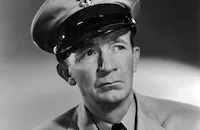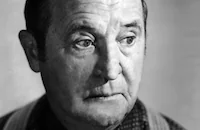Stanley and Livingstone
Brief Synopsis
Cast & Crew
Henry King
Spencer Tracy
Nancy Kelly
Richard Greene
Walter Brennan
Charles Coburn
Film Details
Technical Specs

Synopsis
In the 1800's, Henry M. Stanley, a reporter for James Gordon Bennett, Jr. of the New York Herald , emerges from the snowbound Comanche country bearing an exclusive interview with a rampaging Indian chief. Back in New York, Bennett impresses Stanley with the importance of finding long-missing British doctor David Livingstone in Africa, the biggest news story in the world. Stanley accepts the assignment and, accompanied by Indian scout Jeff Slocum, voyages to Zanzibar, where he meets Eve Kingsley. Fearful of the ravages that Africa has visited upon her late mother and enfeebled father, Eve urges him to give up the mission. Stanley ignores Eve's advice and assembles a safari. Pushing westward, the safari is beset by hostile native attacks and ravaged by fever, but just as things seem hopeless, natives bring word of Livingstone's location. With renewed hope, Stanley pushes on until he finds the doctor living in a native village, practicing medicine and preaching the gospel. To the reporter's surprise, Livingstone insists upon remaining in Africa to carry on his good works, and he gradually converts Stanley to his discipline. Believing that the curtains hiding Africa must be opened, the doctor shows Stanley maps of his previous explorations. After Livingstone is stricken with fever, Stanley returns to London, where he creates a world sensation with his stories of Livingstone's works. However, the British Geographical Society, influenced by the publisher of the London Globe , which has printed news of Livingstone's death, refuses to accept Stanley's evidence. As the society rejects Stanley's claims, word comes that Livingstone has died of fever, and as his last request he asked that Stanley carry on the work that he began. Honoring Livingstone's dying wish, Stanley gives up his job to return to Africa.

Director
Henry King
Cast

Spencer Tracy

Nancy Kelly

Richard Greene

Walter Brennan

Charles Coburn

Sir Cedric Hardwicke

Henry Hull

Henry Travers

Miles Mander
David Torrence

Holmes Herbert
Montague Shaw

Brandon Hurst
Hassan Said

Paul Harvey

Russell Hicks
Frank Dae
Paul Stanton

Joseph Crehan
Robert Middlemass
Frank Jaquet
Clarence Derwent
William A. Williams
Ernest Baskett

Emmett Vogan
James Mcnamara
William Dunn
Emmett Smith
Jack Clisby
Dick Stanley
Tom Coleman
William E. "red" Blair

Frank Orth
Billy Watson
Vernon Dent
Everett Brown
F. Philip Sylvestre
Speirs Ruskell
Anthony Marsh
Eric Lonsdale
Clive Morgan
Imboden Parrish
Harry Harvey
Crew
George Barnes
Joe Behm
Lionel Bevans
Dick Billings
Teresa Brachetto
M. Braggins
Otto Brower
Alfred Bruzlin
David Buttolph
William Darling
William Drake
George Dudley
Philip Dunne
Bob Fritch
Sol Halprin
Sam Hellman
Roger Heman
Karl Herlinger
H. R. Hobson
Newton House
Ollie Hughes
L. V. Johnson
Mrs. Martin Johnson
Julien Josephson
Buddy King
A. J. Klein
Max Larey
Bob Lee
Thomas Little
Harold Lloyd Morris
Hal Long
Kenneth Macgowan
Jack Mcedwards
Barbara Mclean
Owen Mclean
Paul Mcvey
Ferdinand Meine
Rose Moser
C. E. Richardson
Harry Roberts
Irving Rosenberg
Royer
Louis Silvers
Ben Silvey
William Sittell
Jack Stubbs
A. S. Sullivan
Sidney Wagner
Jack Warren
Robert Webb
Henry Weinberger
Walter Whaley
Louis J. Witte
Darryl F. Zanuck

Film Details
Technical Specs

Articles
Stanley and Livingstone - Stanley and Livingstone
20th Century Fox had planned a film called Henry M. Stanley for production in 1937, and sent second-unit director Otto Brower and a crew to Africa to shoot backgrounds. According to press reports, they were "besieged by fever, mutiny and attacks from African tribes," much in the same way that both the real Stanley and Livingstone expeditions had been. Production was further delayed by script rewrites and casting. Some sources say Tyrone Power was originally supposed to play Stanley, others that he was to perform the role of Gareth Tyce, ultimately played by Richard Greene. MGM agreed to loan Spencer Tracy to play Stanley only after production on Northwest Passage (1940) was delayed. It was a triumphant homecoming for Tracy, who had begun his film career at Fox. Shortly after production on Stanley and Livingstone (1939) got underway, Tracy was awarded his second Oscar® in a row for his performance as Father Flanagan in 1938's Boys Town. Presenting the award was Sir Cedric Hardwicke, who played Livingstone. Stanley and Livingstone would be Tracy's only film of 1939.
As was common at the time, the facts of the Stanley-Livingstone saga were highly fictionalized and romanticized in the film. It's true that Livingstone was a minister, and part of the reason he went to Africa was as a medical missionary. But the motives for his travels were more complex. He was as much an explorer, a scientific investigator, and an anti-slavery crusader as he was a proselytizer. As for Stanley, the film gives him a totally superfluous and fictitious romance. And even critics of the era derided Stanley and Livingstone's sanctimonious ending. It is true that Stanley returned to Africa after Livingstone's death, but it was for purposes of exploration and empire building, not to follow in Livingstone's footsteps as a missionary.
Most critics acknowledged the hokum, but appreciated Stanley and Livingstone as a rousing adventure story, and praised the performances. The New York Times called it "intelligent, restrained, and dignified," and lauded the script and actors for underplaying the story's most famous moment. So did Newsweek: "The film's ring of truth is sounded by the exceptional performance of Sir Cedric Hardwicke as a credible Livingstone and Spencer Tracy as Stanley, who reads that classic emotional understatement made at Ujiji - Dr. Livingstone, I presume - as a dramatic summation rather than a time-worn gag-line." Just as impressive as Tracy's succinct and low-key delivery of the climactic line was his way with the longer speeches and narration. Near the end of Stanley and Livingstone, a speech, in which he describes his adventures in Africa to the Royal Geographical Society, ran 442 words.
Director: Henry King
Producer: Kenneth Macgowan, Darryl F. Zanuck
Screenplay: Philip Dunne, Julien Josephson, based on historical research and story outline by Hal Long, Sam Hellman
Cinematography: George Barnes, Otto Brower
Editor: Barbara McLean
Costume Design: Royer
Art Direction: William Darling, George Dudley
Music: Louis Silvers
Principal Cast: Spencer Tracy (Henry M. Stanley), Nancy Kelly (Eve Kingsley), Richard Greene (Gareth Tyce), Walter Brennan (Jeff Slocum), Charles Coburn (Lord Tyce), Sir Cedric Hardwicke (Dr. David Livingstone), Henry Hull (James Gordon Bennett, Jr.), Henry Travers (John Kingsley).
BW-101m.
by Margarita Landazuri

Stanley and Livingstone - Stanley and Livingstone
Quotes
Dr. Livingstone, I presume?- Henry M. Stanley
Trivia
Otto Brower and Osa Johnson followed Stanley's path through Kenya, Tanganyika and Uganda with their crew and returned with 100,000 feet of film for use in the safari sequences.
The movie was dubbed into Spanish, Portuguese and Dutch.
Neither Spencer Tracy nor Walter Brennan ever actually went to Africa during the making of this film. Stand-ins for both of them were used in the long shots during the safari sequences, and whenever Tracy or Brennan were shown "on safari" in close-up against African scenery, they were acting in front of a rear projection screen.
Notes
The working title of this film was Henry M. Stanley. According to pre-production news items in Hollywood Reporter, Fox intended to produce this film for its 1937-38 schedule, but postponed production in order to allow Osa Johnson time to film backgrounds. Another pre-production news item in Hollywood Reporter adds that Tyrone Power was to play the role of "Gareth Tyce" but scheduling prevented him from doing so. Materials contained in the Twentieth Century-Fox Records of the Legal Department at the UCLA Theater Arts Library note that in 1939, Fox bought the rights to David Livingstone, a 1936 British "quota" film produced by James A. Fitzpatrick, to keep it out of the American market and out of competition with this film. According to news items in Hollywood Reporter and Fox publicity materials contained in the Production Files at the AMPAS Library, in 1937, Osa Johnson and Otto Brower led a camera crew through Kenya, Tanganyika and Uganda, following the footsteps of Livingstone. They returned with 100,000 feet of exposed film. Articles in New York Times add that the filming was beseiged by fever, mutiny and attacks from African tribes. Another item in the New York Times notes that six versions of the story were written before Spencer Tracy and the studio approved it. American locations were shot at Sun Valley, ID and Victorville, CA.
Another news item in Hollywood Reporter notes that this picture, budgeted at $2,000,000 with $125,000 allotted for music, had one of the largest music budgets to date. Paul McVey served as a technical advisor for the background jungle music and native chants. An April 1939 item in Hollywood Reporter adds that production on the film was suspended for ten days while a new sequence, budgeted at $100,000, was prepared to expand Spencer Tracy's role. According to a news item in Hollywood Reporter, M-G-M agreed to loan Tracy to Fox for this film after the studio postponed the production of Northwest Passage and Walter Brennan was borrowed from Samuel Goldwyn's company for this picture.
Materials contained in the Twentieth Century-Fox Produced Scripts Collection at the UCLA Theater Arts Library disclose that Ernest Pascal and Edwin Harvey Blum worked on a treatment and continuity and Sheridan Gibney wrote revisions, but their contribution to the final film has not been confirmed. The Twentieth Century-Fox Records of the Legal Department also at the UCLA Library add that the film credits were to have read "based on the diary and Autobiography of Henry M. Stanley," but this statement was deleted because the studio feared a lawsuit by the owners of the Stanley diaries. Contracts contained in the Legal Files disclose that Blue Washington was to have played the role of Mombay, Darby Jones was to play a man with a scar, and Harry Strang was to play the role of the Captain. Their participation in the final film has not been confirmed. The film was dubbed into Spanish, Portuguese and Dutch. The picture was included in Film Daily's "ten best" list of 1939.














